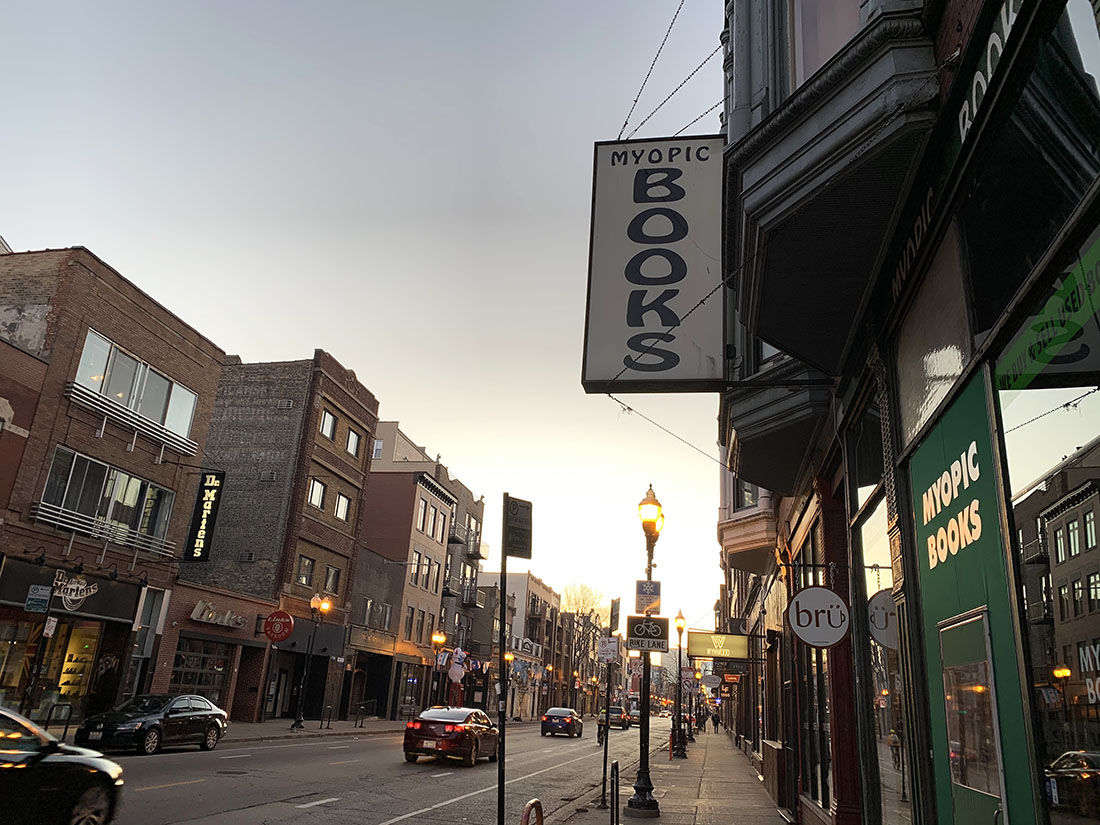By Hannah Farrow
Medill Reports
Between same-day shipping and instant Kindle ebooks, Amazon dominates book sales. Borders went out of business in 2011. Barnes & Noble was sold this year after its worst year in sales to date; they’ve also closed over 150 stores in the last decade. Yet the entire country is seeing a spike in independent brick-and-mortar bookstores and their sales. In Wicker Park alone, a neighborhood known for the arts, three thrive: Volumes, Myopic and Quimby’s.
“Myopic is the used books. Volumes is the family friendly. And we’re the weirdos,” said Liz Mason, 45, manager of Quimby’s. “We all have different vibes, and we all fulfill different needs. Honestly, in my mind, it feels like I have collaborators in getting Wicker Park to be more literary.”
According to the American Booksellers Association (ABA), sales at indie bookstores are on the rise. National sales rose by 2.6% from 2016 to 2017. In 2018, the sales were up approximately 5% over 2017. ABA’s main reasoning for the increase is the public’s demand for discovering new authors and titles in a unique space.
“Shopping local can be a little more expensive or a little less convenient,” said Justin McCraw, 32, who wandered into Volumes over the Thanksgiving holiday to purchase a book for his boyfriend. “But it’s, I think, great to give back to your community. And if you don’t patronize these stores, then they won’t exist.”
The three Wicker Park bookstores are within a quarter mile of each other, and each plays a part in maintaining the neighborhood’s art culture. Between author events, comedy shows, open mic nights and poetry series, each bookstore offers a unique experience to the community.
“These little book shops that offer not only books, but toys and reading events, provide a sense of community and places for people to hang out and get a sense that they’re part of something bigger than a Walmart or something could offer,” McCraw said.
Quimby’s is known for its aberrant material and independent publications. While they do sell a lot of things that Amazon has, like graphic novels and books, what gets people in the door are zines and mini comics.
“In some ways, I feel like we’re an indicator of what Wicker Park once was,” said Mason, Quimby’s store manager.
In the 1980s, two neighborhood developers bought the Flat Iron Arts Building and leased the space out to artists and non-profits for affordable prices, helping Wicker Park become an artists’ hub. Local galleries opened up, aspiring musicians performed at small venues, the streets were buzzing with ideas.
“The ‘90s are what people think of when they think of the arts in Wicker Park,” said Jordan Miller, 29, the art and social media administrator for Wicker Park Bucktown Chamber of Commerce. “We want to make sure we’re doing something to promote those spaces that are in the neighborhood and still actively participating in the arts.”
Miller helps create a weekly arts guide that highlights the events happening every Thursday, Friday, Saturday and Sunday in Wicker Park and Bucktown. So far, he’s helped create over 100 guides.
“We have a direct line of communication with our public and people in our neighborhood and the city,” Miller said. The bookstores, he said, “are part of what we promote in our weekend arts guide pretty regularly. Volumes does something almost every weekend. Myopic is fairly common to see, especially through their poetry series. Quimby’s does a ton of programming.”
From 2009 to 2019, the number of independent bookstores across the U.S. rose from 1,651 to 2,524, according to ABA. Despite Amazon disrupting the book industry with its ease of shopping online, the ABA said the demand for an authentic experience takes precedence. Even Barnes & Noble’s new CEO is creating a plan to make each brick-and-mortar shop feel more like an independent bookstore.
“At this point, there are very few places that are left that are a part of the tradition of our literary and artistic community,” Mason said. “We’ve evolved over time to stick within the spirit of the store, but also to accommodate the 2019 wants.”
One of those wants, according to Volumes Bookcafe co-owner Rebecca George, is events.
“An independent bookstore by nature becomes a community hub because it’s a place filled with hope, a place with ideas, a place filled with conversation,” George, 39, said. “We try to evoke a sense of place where everyone will feel welcome.”
The spike in success of independent bookstores has drawn the attention of Ryan Raffaelli, the assistant professor of Business Administration Organizational Behavior Unit at Harvard Business School. He conducted a study on how independent bookstores thrive and boiled his findings into three C’s: community, curation and convening.
“Independent bookstore owners were responsible for raising initial awareness for localism, creating a movement that attached normative values with their economic interests,” Raffaelli writes in the extended abstract. “Independent booksellers were able to reclaim market demand by amplifying a unique set of practices that distinguished them from other actors in the bookselling industry.”
The abstract continues to say independent bookstores “provide a more personal and specialized customer experience to hand-sell each book.”
As Barnes & Noble revamps its stores to become more local, Volumes, Myopic and Quimby’s are well ahead of the curve.
“You don’t want to totally change the store to get away from its original statement of intent or mission statement, but you also want to stay in business,” Mason said. The customers’ reactions when they wander into Quimby’s for the first time, Mason said, is “they walk around and come up to the counter and buy something very inexpensive, and say, ‘I need to come back when I have more time.’”

